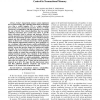Free Online Productivity Tools
i2Speak
i2Symbol
i2OCR
iTex2Img
iWeb2Print
iWeb2Shot
i2Type
iPdf2Split
iPdf2Merge
i2Bopomofo
i2Arabic
i2Style
i2Image
i2PDF
iLatex2Rtf
Sci2ools
114
Voted
MICRO
2010
IEEE
2010
IEEE
Hardware Support for Relaxed Concurrency Control in Transactional Memory
Today's transactional memory systems implement the two-phase-locking (2PL) algorithm which aborts transactions every time a conflict happens. 2PL is a simple algorithm that provides fast transactional operations. However, it limits concurrency in applications with high contention by increasing the rate of aborts. More relaxed algorithms that can commit conflicting transactions have recently been shown to provide better concurrency both in software and hardware. However, existing approaches for implementing such algorithms increase latencies of transactional operations, require complex hardware support and alter standard cache coherence protocols. In this paper, we discuss how a relaxed concurrency control algorithm can be efficiently implemented in hardware. More specifically, we use a technique which approximates conflict-serializability and implement it in hardware on top a base hardware transactional memory system that provides support for isolation and conflict detection. Our ...
Related Content
| Added | 20 May 2011 |
| Updated | 20 May 2011 |
| Type | Journal |
| Year | 2010 |
| Where | MICRO |
| Authors | Utku Aydonat, Tarek S. Abdelrahman |
Comments (0)

